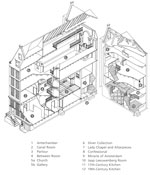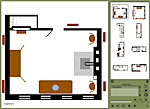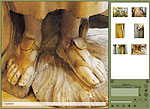Our Lord in the Attic: A Case Study
Confessional
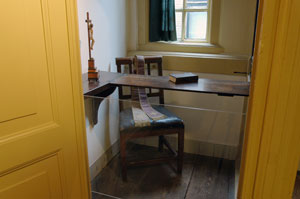 The stairs at the Lady chapel lead down to the confessional, located on the first floor of the second rear house.
The confessional was moved here around 1740. Few churches would have had such a simple confessional space. The penitent kneels in the closet-like space to confess their sins to the priest. After the priest has prescribed a suitable punishment - with the authority of the Church - various prayers are said.
When taking confession, the priest wears a stole; a prayer book and a crucifix are also kept in the confessional.
The stairs at the Lady chapel lead down to the confessional, located on the first floor of the second rear house.
The confessional was moved here around 1740. Few churches would have had such a simple confessional space. The penitent kneels in the closet-like space to confess their sins to the priest. After the priest has prescribed a suitable punishment - with the authority of the Church - various prayers are said.
When taking confession, the priest wears a stole; a prayer book and a crucifix are also kept in the confessional.
Launch image viewer of floor plans
Launch image viewer of the confessional
![]() 'Description of area' database (PDF, 664KB)
'Description of area' database (PDF, 664KB)
Description of the space
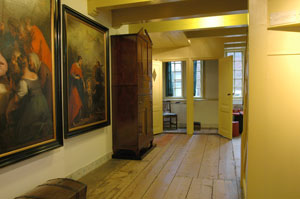 The confessional was installed around 1740, a simple cupboard style room with one room for the priest (left) and one for the confessor (right). Few churches would have had such a simple confessional chair. The penitent kneels in the closet-like space to confess their sins to the priest. After the priest has prescribed a suitable punishment - with the authority of the Church - various prayers are said.When taking confession, the priest wears a stole; a prayer book and a crucifix are also kept in the confessional.
The confessional was installed around 1740, a simple cupboard style room with one room for the priest (left) and one for the confessor (right). Few churches would have had such a simple confessional chair. The penitent kneels in the closet-like space to confess their sins to the priest. After the priest has prescribed a suitable punishment - with the authority of the Church - various prayers are said.When taking confession, the priest wears a stole; a prayer book and a crucifix are also kept in the confessional.
Visitors can enter the right hand side and are even allowed to kneel on a little foot stool. The priest’s side is closed off with Perspex sheeting, to avoid entry. The objects on the priest’s side are secured to the table using screws, to prevent theft.
Launch image viewer of the statues of St. Peter and St. Paul
![]() Collection catalogue (PDF, 5.5MB)
Collection catalogue (PDF, 5.5MB)
![]() Database area reference key (XLS, 571KB)
Database area reference key (XLS, 571KB)
Collection on display
Two altarpieces by Jacob de Wit (1695‑1754) are hung on the wall: the Adoration of the Shepherds (1726, oil on canvas, 138 x 103 cm) and the Holy Family and Trinity (1726, oil on canvas, 140 x 105 cm). These were made for a private church just outside Amsterdam.
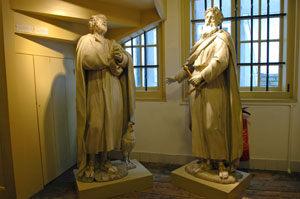 In an alcove underneath the stairs, two large size monochrome wooden statues can be found: St. Peter and St. Paul. They date back to 1735/1736 and were originally located in the French church in Amsterdam, which collection was sold in 1912. It is unclear when exactly these statues entered the building, but they were definitely here in 1952. The two statues are moved away from their location each Christmas to make way for the nativity scene.
In an alcove underneath the stairs, two large size monochrome wooden statues can be found: St. Peter and St. Paul. They date back to 1735/1736 and were originally located in the French church in Amsterdam, which collection was sold in 1912. It is unclear when exactly these statues entered the building, but they were definitely here in 1952. The two statues are moved away from their location each Christmas to make way for the nativity scene.
